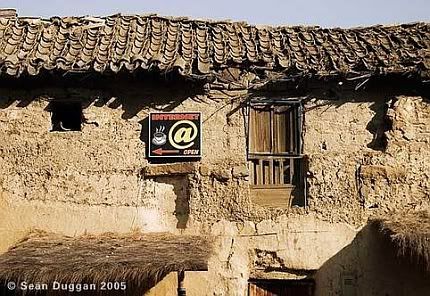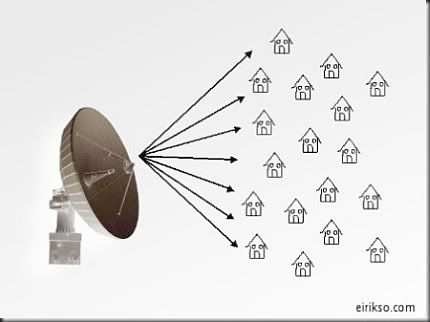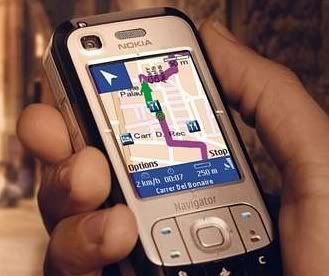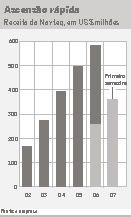 |
| October 2, 2007 Its Creators Call Internet Outdated, Offer Remedies By BOBBY WHITE. |
 |
| |
| In 1969, at the Pentagon's Advanced Research Projects Agency, Larry Roberts oversaw a program of connected research computers called ARPAnet that became the foundation for the Internet. Four decades later, he has spent nearly $340 million trying to redo that same technology, which he now believes is far behind the times. "We can no longer rely on last-generation technology, which has essentially remained unchanged for 40 years, to power Internet performance," says Mr. Roberts, who is 69 years old. Last month, his start-up, Anagran Inc., introduced a piece of gear called the flow router that he says can help modernize the Internet. The equipment analyzes Web traffic to discern whether it is an email, a movie or a phone call and then carves out the bandwidth needed for transmission. Mr. Roberts isn't the only networking pioneer dissatisfied with earlier achievements. Len Bosack, the 55-year-old co-founder and former chief technology officer of networking giant Cisco Systems Inc., helped commercialize routers, the core piece of networking equipment that allows computers to communicate with one another. Yet he now terms such gear "less and less adequate" for today's Internet needs. Last month, his company, XKL LLC, unveiled a system that allows businesses to connect to underground cables that have nearly 100 times the capacity of current telecommunications pipes. The actions of Messrs. Bosack and Roberts fuel the growing debate over whether the Internet's current infrastructure is sufficient to handle the explosion of bandwidth-hungry services such as Internet telephony and video. In a recent report, Cisco calculated that monthly Internet traffic in North America will increase 264% by 2011 to more than 7.8 million terabytes, or the equivalent of 40 trillion email messages. If such Internet traffic continues increasing, many believe networks could crash or at least slow to a crawl. "The increasing bandwidth demands on cable operators will soon reach crisis stage," wrote Stan Schatt, research director at ABI Research, in a recent report. Others disagree. Cisco, even with its forecast of great traffic growth, concludes Internet-service providers will be able to cope. Today, information travels the Web by being broken into tiny bits called packets, which are routed through the least congested pipes to their destination. Once the packets arrive, they are reassembled into their original form. The problem is that the increasing size of files, such as video, has begun overwhelming some equipment handling the traffic, resulting in errant or lost packets. To tackle the problem, a slew of start-ups are producing gear and software to accelerate Internet traffic or to increase the network's capacity. These include companies run by Messrs. Roberts and Bosack, as well as Riverbed Technology Inc. and Big Band Networks Inc. Other companies, such as BitGravity Inc. and Limelight Networks Inc., are creating "parallel networks" -- essentially scaled-down versions of the Internet -- to escape the glut of traffic on current networks. The target buyers for these start-up services are Internet-service providers and big companies with large networks of satellite offices. A business, for instance, can affect how quickly emails and other files flow to their branch offices depending on the equipment they use in their network. But many of the new start-ups aiming to cater to these needs aren't likely to survive. In the late 1990s, start-ups such as Celox Networks Inc., Chiaro Networks Inc. and Centerpoint Broadband Technologies Inc. also emerged to grapple with the growth in Internet traffic. All of those companies have since filed for bankruptcy or shut down, casualties of the telecom bust. Today's Web-traffic-control start-ups "really have their work cut out for them," says Michael Kennedy, a networking consultant with Network Strategy Partners LLC. "Technology doesn't always win the race." |
 |
| Mr. Roberts's concern over the Internet's infrastructure stretches back years. Even while at ARPAnet, he says he was unsure how long the technology could work, especially since the system didn't ensure that information packets would arrive at their destination. His fears crystallized in the late 1990s when he saw companies begin to use the Internet to make phone calls and consumers begin to dabble in online video. "The Internet wasn't designed for people to watch television," he says. "I know because I designed it." In 1998, Mr. Roberts, who worked at several networking start-ups in the 1970s and 1980s after leaving the Defense Department in 1971, founded a start-up called Caspian Networks Inc. He raised $317 million from venture capitalists for Caspian to manufacture the flow-based routers that could analyze Internet traffic and improve how that traffic moved. But the equipment -- priced at about $500,000 per router -- was too expensive for many customers. Mr. Roberts resigned in 2004 from Caspian; the company closed its doors last year. But the scientist's desire to improve the Web's infrastructure didn't abate. Two months after leaving Caspian, Mr. Roberts founded Anagran in Redwood City, Calif., and raised $22 million in venture funding to continue his work. This time around, he says, Anagran's product is cheaper -- costing just $70,000 -- and there is a more urgent need for such equipment. "Larry wants to get it right," says Dan Brown, a venture capitalist at ArrowPath Venture Partners in Redwood Shores, Calif., which has invested in Anagran. Anagran has already picked up customers such as Merit Networks Inc., of Ann Arbor, Mich., a nonprofit organization that builds networks for universities, and the International Center for Advanced Internet Research at Northwestern University. "Larry's equipment is built for the more complex traffic like Internet television," says Jim Chen, assistant director of networking at Northwestern. "It's a perfect fit for us." The XKL story began in Seattle in 1991, a year after Mr. Bosack and his former wife, Cisco co-founder Sandy Lersner, were ousted from Cisco. At the time, Cisco had just gone public and the company's venture capitalists figured the duo could no longer run the growing enterprise. Mr. Bosack soon sold most of his Cisco stock and concentrated on XKL. There, he focused on increasing the Internet's capacity through fiber optics, which are strands of glass capable of carrying 100 times more data than traditional wires. For more than a decade, Mr. Bosack worked in stealth mode on his technology. At the same time, he began noticing how businesses and consumers were finding unintended uses for the Internet, such as videoconferencing. "Some of this stuff was putting a heavy burden on the network," he says. That led to XKL's introduction of the DMX optical transport system last month. The $100,000 system allows businesses and service providers, rather than telecommunication companies, to manage and connect to fiber lines. XKL has only just begun to sign up customers, says Mr. Bosack. Messrs. Roberts and Bosack haven't met but know of each other through industry circles and say they have been following one another's progress. "We're pushing for the same thing," says Mr. Bosack. "The public needs something better than what's currently available." Write to Bobby White at bobby.white@wsj.com |
| Abrir/Comprar artículo en WSJ Américas. Privacy Policy Subscriber Agreement & Terms of Use Mobile Devices RSS Feeds Copyright © 2007 Dow Jones & Company, Inc. All Rights Reserved |
jueves, octubre 04, 2007
Los creadores de Internet dicen que ésta ya está obsoleta. Ofrecen soluciones.
miércoles, octubre 03, 2007
Red Wi-Fi para la educación.
 |
| 02/10/2007 TODA LA COMUNIDAD UNIVERSITARIA DISPONDRÁ DE CONEXIÓN INALÁMBRICA WI-FI GRACIAS AL PROGRAMA «CAMPUS EN RED». Tecnología. Web2.0 |
 |
| Servicio de Internet por WiFi |
| La iniciativa que extenderá las redes wifi ha sido impulsada por el Ministerio de Industria, Turismo y Comercio, a través de red.es, y por el Ministerio de Educación y Ciencia El programa beneficia a más de 1.283.000 estudiantes, cerca de 90.000 profesores y casi 40.000 trabajadores del personal administrativo y de servicio Con el objetivo de promover la iniciativa se ha puesto en marcha un plan de comunicación con elementos de señalética, campañas de publicidad y eventos tecnológicos en las universidades El Ministerio de Industria, Turismo y Comercio y el Ministerio de Educación y Ciencia han presentado hoy el programa Campus en Red, una iniciativa que permitirá a 44 universidades públicas disponer de cobertura inalámbrica para desarrollar futuros servicios de valor añadido e innovación. Campus en Red forma parte del Plan Avanza (www.planavanza.es) para el desarrollo de la Sociedad de la Información en España y cuenta con un presupuesto de 7,8 millones de euros. El programa permitirá a las universidades participantes disponer de cobertura inalámbrica del 85% para poder desarrollar servicios de valor añadido e innovación como e-learning, localización o transmisión de voz a través de las redes IP (VoIP). La comunidad universitaria que se beneficiará de estos servicios incluye a más de 1.283.000 estudiantes, cerca de 90.000 profesores y casi 40.000 trabajadores del personal administrativo y de servicio. Con la finalidad de crear un espacio único de movilidad, Campus en Red facilitará el acceso a Internet de estudiantes y profesores cuando se encuentren desplazados en otras universidades españolas y extranjeras, adheridas al servicio MovIRIS/Eduroam (www.eduroam.es), que en España gestiona RedIRIS, la red académica y de investigación vinculada a red.es. Plan de comunicación y difusión Con la intención de promover Campus en Red se ha puesto en marcha un plan de comunicación y de difusión en las universidades. Por medio de diferentes elementos de señalética,- rótulos y carteles- se pretende facilitar la localización de los espacios de cobertura wifi en cada una de las 44 universidades que participan. También está previsto desarrollar sucesivas campañas de publicidad y comunicación en medios y se repartirán, entre los estudiantes, dípticos y folletos informativos que especifiquen los requisitos necesarios para habilitar su conexión. La página web www.campusenred.es servirá de plataforma de comunicación del programa "Campus en Red". Dentro de las actividades que están previstas para promover el uso de estas redes en las universidades destaca la celebración de diferentes eventos tecnológicos. Concretamente en cuatro universidades españolas se crearán espacios chill-out donde los asistentes se podrán conectar directamente desde sus propios equipos y se ofrecerá información sobre las utilidades de la tecnología wifi. La tecnología WIFI (del inglés Wireless Fidelity) es un conjunto de estándares para redes inalámbricas (WLAN) basado en las especificaciones IEEE 802.11, que permite que los usuarios accedan a los recursos de la red desde cualquier punto con cobertura, sin necesidad de cables. FUENTE: Ministerio de Industria, Turismo y Comercio ENLACE: www.mityc.es |
| © 2007 Telefónica S.A. |
martes, octubre 02, 2007
GIS y celulares.
 |
| October 2, 2007 4:05 a.m. Con la compra de Navteq, Nokia aumenta su apuesta por los servicios móviles Por Casell Bryan-Low The Wall Street Journal |
 |
|
|
| Al pagar un precio altísimo para comprar una empresa de servicios de mapas, el fabricante de teléfonos celulares Nokia Corp. trata de posicionarse mejor para competir con los gigantes de Internet como Google Inc. en una de las áreas de mayor crecimiento de la tecnología: los servicios que le indican a uno dónde ir. Nokia, el mayor fabricante de celulares del mundo, anunció ayer la adquisición de la empresa de software de navegación Navteq Corp. por cerca de US$8.100 millones. Esta constituye la mayor compra de los últimos años de la empresa finlandesa. La estadounidense Navteq es líder mundial en el negocio de los mapas electrónicos, los cuales licencia a los fabricantes de sistemas de navegación para automóviles, páginas Web y otras firmas, incluyendo Nokia. La empresa finlandesa espera seguir usando Navteq y vender el software a otros. Google, Yahoo Inc. y Microsoft Corp. siempre han recurrido al software de firmas como Navteq para luego vender los mapas a los usuarios con el fin de que los usen en sus computadoras, teléfonos y otros aparatos. Las compañías de Internet han mejorado sus funciones, dándoles a los consumidores la posibilidad de personalizar los mapas, por ejemplo al marcar lugares en los mapas en línea con notas, video y fotos y luego compartir esa información con amigos. Además, las grandes compañías de Internet se concentran cada vez más en llevar sus paquetes de servicios a los teléfonos celulares. Nokia "está planteando realmente un desafío" a las grandes empresas de Internet, afirma Ben Wood, un analista de la firma de investigación en telefonía celular Insight. Nokia se movió con rapidez para cerrar su acuerdo después de que el fabricante de aparatos de navegación TomTom NV decidiera comprar al principal rival de Navteq, Tele Atlas NV. TomTom, con sede en Amsterdam, acordó en julio comprar a la belga Tele Atlas por aproximadamente US$2.800 millones. En un escenario en el que sólo existen dos grandes compañías de mapas electrónicos, y en el que ambas parecen estar estrechamente relacionadas con un fabricante de aparatos específico, algunos analistas e inversionistas cuestionan si Nokia obtendrá la aprobación de las autoridades antimonopolio. Algunos clientes de Navteq podrían ver en Nokia un posible competidor y dejar de comprar sus productos, sugieren algunos analistas. |
 |
| En un esfuerzo por aliviar estos temores, Nokia dice que su intención es que las operaciones de Navteq sigan siendo independientes tras la adquisición. El director de finanzas de Nokia, Richard Simonson, asegura que "no tenemos nada que nos impida conseguir el visto bueno" por parte de las autoridades antimonopolio. Fuentes familiarizadas con el acuerdo aseguraron que Nokia estaría preparada para, en caso de necesidad, hacer algunas concesiones que apacigüen a los reguladores. La apuesta de Nokia por penetrar el sector de los servicios de navegación corre el riesgo de molestar a sus mayores clientes, los proveedores de telefonía celular, muchos de los cuales han invertido grandes cantidades de dinero para ofrecer por sí mismos contenidos, tales como juegos y mapas. Algunos analistas sugieren que Nokia está pagando un precio demasiado alto, equivalente a unas 50 veces los ingresos pronosticados para 2007 de Navteq. El fabricante finlandés acordó pagar US$78 por cada título bursátil de Navteq, lo cual está tres centavos de dólar por encima del precio de cierre del viernes en la Bolsa de Nueva York. Ayer, las acciones de Navteq cayeron 1,95%, a US$76,38. Aun así, el precio del título se ha más que duplicado en lo que va de año. Simonson defendió el precio diciendo, "cuando algo tiene valor, uno tiene que pagar por ello". El giro hacia las funciones de mapas forma parte del esfuerzo del presidente ejecutivo de Nokia, Olli-Pekka Kallasvuo, de expandirse a los servicios, que también incluyen los juegos, fotos, videos y las comunidades de redes sociales en línea. Kallasvuo ve en estas áreas nuevas fuentes de ingresos y una manera de lograr que sus teléfonos celulares sean más deseables. |
| Abrir/Comprar artículo en WSJ Américas. Privacy Policy Subscriber Agreement & Terms of Use Mobile Devices RSS Feeds Copyright © 2007 Dow Jones & Company, Inc. All Rights Reserved |
